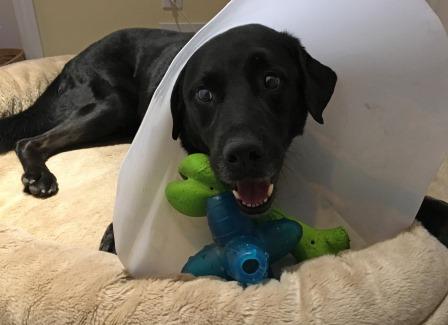Can Cats Have Moles On Their Skin

The pare is an amazing part of the trunk. It is the first line of defense against infection and contains a number of specialized cells that produce hair, class the oil glands and the sweat glands. In addition there are tissue cells that assist the body withstand and repair itself from day to 24-hour interval trauma that occurs with sunday, heat, and cold exposure, abrasions, cuts and bruises and other trauma. Only similar people, dogs and cats accept pigments and freckles in the skin that can vary with their glaze color, their breed, and the location on the trunk. And they are at risk for skin growths.
Champ is our Pet of the Month for April because he highlights the importance of investigating pare growths quickly. Champ is my own dog. He is a ix year old Labrador Retriever who comes to work with me every day. Champ was adopted from a shelter three and a half years agone and came to us with 'issues' – he has separation anxiety, panics with thunder, and he can jump out of our tallest dog runs – so he spends his day in my office or with employees when they have time to give him belly rubs. Ane of the benefits of existence Champ is that in that location are a lot of eyes paying attention to him on a regular basis!
 A few weeks ago, despite all of this regular attention, it was surprising to suddenly detect a raised black growth on Champ's belly virtually one of his nipples. It literally seemed like this growth appeared overnight. It was about the size of a grain of rice, black and slightly raised above the surface of the peel. A pigment spot or freckle can be various shades of light to dark but they are always flat to the skin surface. Dogs don't typically become moles like people, so immediately I was concerned about Melanoma. Two days later I took him to surgery. The biopsy written report confirmed that this small little black tissue was a melanoma. Champ was fortunate that the location on his body immune a wide surgical margin of normal peel effectually the cancerous tissue and his prognosis is likely very skillful.
A few weeks ago, despite all of this regular attention, it was surprising to suddenly detect a raised black growth on Champ's belly virtually one of his nipples. It literally seemed like this growth appeared overnight. It was about the size of a grain of rice, black and slightly raised above the surface of the peel. A pigment spot or freckle can be various shades of light to dark but they are always flat to the skin surface. Dogs don't typically become moles like people, so immediately I was concerned about Melanoma. Two days later I took him to surgery. The biopsy written report confirmed that this small little black tissue was a melanoma. Champ was fortunate that the location on his body immune a wide surgical margin of normal peel effectually the cancerous tissue and his prognosis is likely very skillful.
Melanomas:
- Melanomas can occur anywhere on the body including in the mouth, on the top of the nose, in the eye, effectually boom beds; anywhere pigment cells are present.
- In that location may be a genetic component to melanomas in dogs every bit certain breeds take a higher incidence.
- Melanomas that involve the oral fissure and nail beds are more commonly malignant and can be difficult to surgically excise completely.
- Despite their name, not all melanomas are blackness – some are amelanotic melanomas which tin appear like normal peel, or may be red, pink, purple.
- Non all melanomas are cancerous – some can be considered beneficial and surgical excision is curative.
- Malignant melanomas can metastasize to distant parts of the body – lymph nodes and lung or liver being most common.
- Survival times depend on the verbal nature of the tumor, how successfully it has been removed, which part of the body, and follow-up treatments.
 Fortunately in that location are some encouraging developments for canine patients. The Michigan Land Melanona Prognositc Console uses special testing methods to classify and predict how a particular tumor will carry. In consultation with a veterinary oncologist, this test tin can aid determine how malignant a particular tumor is, and provide information to assist with handling planning, In addition, the Canine Melanoma Vaccine, which utilizes Dna Immunotherapy, can exist used to care for patients who have been diagnosed with Malignant Melanomas and substantially improve their survival.
Fortunately in that location are some encouraging developments for canine patients. The Michigan Land Melanona Prognositc Console uses special testing methods to classify and predict how a particular tumor will carry. In consultation with a veterinary oncologist, this test tin can aid determine how malignant a particular tumor is, and provide information to assist with handling planning, In addition, the Canine Melanoma Vaccine, which utilizes Dna Immunotherapy, can exist used to care for patients who have been diagnosed with Malignant Melanomas and substantially improve their survival.
At Hawthorne Hills Veterinary Infirmary nosotros encourage you to exist proactive in addressing any lump or crash-land on the skin or under the skin that your pet may develop. This means getting an test early, having the tissue evaluated either with a Fine Needle Aspirate or surgical excision and getting a definitive answer. There are many growths that are benign, just if it turns out to be cancerous, early on intervention helps provide the best possible result.
Links:
- http://wearethecure.org/learn-more-about-canince-cancer/canine-cancer-library/melanoma-melanocytic-tumors/
- https://world wide web.vet.upenn.edu/docs/default-source/ryan/oncology-handouts/melanoma.pdf?sfvrsn=4
- http://www.veterinarypartner.com/Content.plx?P=A&South=0&C=0&A=2941
- http://www.petcancervaccine.com/Pages/default.aspx
Source: https://hhvh.net/2017/04/17/whats-that-black-spot-on-my-pets-skin/
Posted by: cranewern2000.blogspot.com

0 Response to "Can Cats Have Moles On Their Skin"
Post a Comment